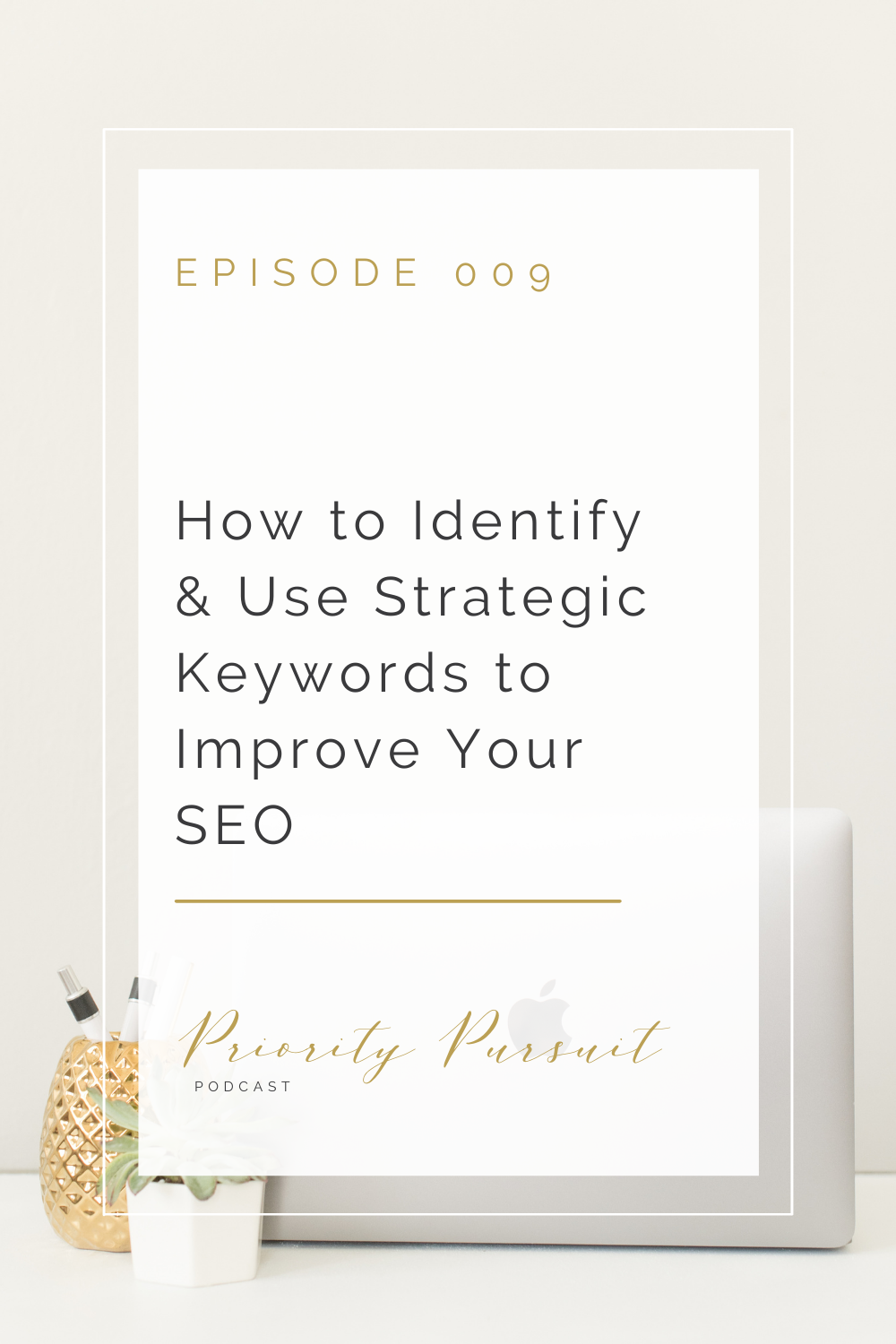Let's Connect!
Check Out Wedding Photography Packages]
I understand how much your wedding photos mean to you and how much work you’re putting into planning every last detail of your big day. As a VRP bride, you can relax and enjoy your wedding day knowing you’ve chosen a team of photographers who are just as detail-oriented as you are, will put thought into every shot, and will pay attention to all of the little details to ensure that you and your spouse love your wedding photos.
And, I’m an Indy wedding photographer for the type-A bride.
I'm Victoria Rayburn
Hey there!
Spotify | Apple Podcasts | Stitcher
Welcome to another episode of The Priority Pursuit Podcast! I’m particularly excited about this episode, because SEO is one of my favorite marketing tactics to discuss.
Now, I know it might seem funny that I get thrilled about something so seemingly boring and complicated. But, I’m passionate about search engine optimization because I know SEO has the power to give small businesses and creative entrepreneurs big results.
In fact, every year, 40% of my clients find me on Google, meaning 40% of my annual income is a result of the fact that my website ranks well on search engines. (Referrals are responsible for approximately 55% of my business, and social media actually only accounts for 5%. But, social media does help me stay top of mind, so it’s a great investment of my time.)
If you haven’t tuned into or read “Episode 004: Five Ways to Improve Your SEO for Free,” I highly recommend listening to/reading that episode before diving into this one.
But, in this particular episode of Priority Pursuit, we’re going to break down how you can identify and use strategic keywords to improve your SEO and get your website, blog posts, and other content in front of your ideal customers, so you can make more sales!
What are keywords?
First of all, what are keywords?
Moz defines keywords as, “Ideas and topics that define what your content is about. In terms of SEO, they’re the words and phrases that searchers enter into search engines.”
In other words, keywords are the words or phrases that people Google, and as a business owner, you want to include relevant keywords on your webpages and in your blog posts so that you can get your website in front of potential customers who are specifically looking for your products, services, or content.
For example, because I’ve optimized my homepage for “Wedding Photographer in Lafayette, Indiana,” my website is one of the first to appear when people are looking for wedding photographers in the Lafayette, Indiana area. This allows me to get my services and information in front of people who are actively shopping for what I have to offer. And, that’s a very powerful thing!
To be strategic, you need to optimize your webpages & blog posts with long-tail keywords.
A common mistake that creative entrepreneurs make is optimizing their websites for broad keywords (head keywords) instead of specific keywords (long-tail keywords).
We’ll discuss the differences between head and long-tail keywords below, but basically, it’s important to understand that it will be much easier and more beneficial for your website to rank for long-tail keywords than for head keywords.
Head Keywords
Broad keywords—also called “head or singular keywords”—are usually one or two words. For a wedding photographer, examples of head keywords might include “wedding photographer,” “photographer,” “wedding photos,” “engagement photographer,” and other broad words that describe a wedding photographer’s services.
Head keywords have high search volumes, so it’s a common mistake for people to think that these are the keywords they should be using to optimize their websites. But, this is not the case, especially for small businesses.
We’ll stick with our wedding photographer example. The average wedding photographer won’t be able to rank on the first page of a Google search for “wedding photographer” (a head keyword) because there are so many photographers in the world with websites.
Right now, if you Google “wedding photographers,” 1,860,000,000 results appear. That’s a lot of online competition! And, to be honest, it’s practically impossible for even a world-renowned wedding photographer to overcome these numbers and make his or her way to the first page of Google search. (The exception is local search—results that Google shows based on your location when you type in a search query.)
So, how do you combat this? You need to optimize your website with long-tail keywords that your ideal clients will be searching for.
Long-tail Keywords
Long-tail keywords are more specific keywords—ideally made up of four or more words (three words work occasionally)—that better mirror a searcher’s intent.
Long-tail keywords are more powerful than head keywords because, according to Neil Patel, “Long-tail keywords are how people actually search the internet.”
Think about when you search for something. Do you type in one or two words? No. You type in a question or add a description so you can find results that are more relevant to what you need. Examples might include “blush maxi dress with pockets” or “best bloody Mary in Madison, Wisconsin.” In fact, 70% of all Google searches are specific like these examples.
Now, let’s pretend that you’re a wedding photographer in Lafayette, Indiana and that your target audience is brides in Indiana. You don’t need to rank well for “wedding photographer.” Instead, you need to rank well for searches that are relevant and specific to your target audience.
These searches might include “Lafayette, Indiana wedding photographers,” “wedding photographers in Lafayette, Indiana,” “Indianapolis wedding photographers,” “best wedding photographers in Indiana,” or “light and airy wedding photographers in Indiana.”
These long-tail keywords are more specific to your target audience and have less competition, meaning you’re more likely to rank well. For example, only 815,000 results appear when you search “wedding photographers in Lafayette, Indiana.” This seems like a lot, but this is 99.96% less than the 1,860,000,000 listings for “wedding photographer”!
Basically, according to HubSpot, long-tail keywords offer you the path of “least resistance” and are more likely to put you in front of your target audience.
Please Note: Long-tail keywords aren’t just location specific. If you have a service area (like a photographer) or a brick and mortar location (like an ice cream shop), using your location makes sense.
But, let’s pretend you offer a service or product where you can serve anyone anywhere, like a clothing boutique. Long-tail keywords that make sense for you might include “boho women’s online boutique” or—if you’re optimizing for a product page—“blush maxi dress with pockets.” Long-tail keywords like these are more likely to get your website in front of the right people and help your website appear before Nordstrom, Amazon, and other big-name sites.
As you research long-tail keywords for your website, there are five rules of thumb you need to keep in mind.
While common sense will get you a long way, you don’t want to choose your long-tail keywords without looking at data.
Before we get into the nitty gritty, there are a few things that you should note:
- You need a long-tail keyword for every webpage and blog post.
- Every webpage and blog post needs a different long-tail keyword. You cannot use the same keyword on more than one page.
- Your long-tail keyword needs to be relevant to the page you’re using it on. If your keyword isn’t relevant, search engines will see this, and your search ranking may be affected negatively.
- Long-tail keywords have four or more words. You can occasionally use three words if a three-word long-tail keyword complies by the next rule.
- Your long-tail keyword should have between 1-100 searches per month. This helps ensure that your website appears when people are specifically looking for your products or services.
These five things are so important. As you’re choosing your long-tail keywords, be sure to refer to this list.
Now, let’s talk about actual steps and tools you can use to identify and use strategic keywords to improve your SEO!
So, how do you identify long-tail keywords for your webpages and blog posts?
I’m going to give a brief description of how to identify and use strategic keywords (long-tail keywords) below, but if you’re a more visual person, I highly recommend downloading, “A Guide for Photographers: How to Identify Keywords for SEO that Will Help You Book More Clients.”
While this guide was created for photographers, I think it’s safe to say that any creative entrepreneur will find it useful. The guide includes screenshot examples and more specific instructions, while this blog post is simply an overview, because SEO is difficult to explain in text alone.
Want more SEO assistance with screenshot examples? Download “A Guide for Photographers: How to Identify Keywords for SEO that Will Help You Book More Clients”!
1. Create a spreadsheet so you can keep track of which long-tail keyword goes with which webpage or blog post.
Start with a spreadsheet and make four columns: one to list all of your webpages, one to list each page’s coinciding long-tail keyword, one to list each keyword’s average monthly searches, and one to make note of other keywords you’d like to include on each webpage.
Then, go ahead and add all of your webpages (home, about, services, etc.) to the first column.
While you’ll likely put up or update all of your webpages at once, you will (or at least you should) be adding blogs and other content to your website on a regular basis. So, every time you add something new, you’ll want to return to this spreadsheet to:
- Make sure you haven’t already used a long-tail keyword.
- Add the new blog post or page and its long-tail keyword so you have a record that you can easily refer to as you add new content to your site.
2. Brainstorm a list of possible, strategic long-tail keywords.
Next, you want to think like your ideal clients and about their intent. What are they searching for? What do they need from you? Is your location or service area important? What’s important to your ideal clients when they’re looking for a product or service like yours?
With long-tail keywords, user intent is very important because your goal is to get your website in front of the individuals you can serve. So, start by brainstorming a list of keywords that you think might be relevant.
After you’ve brainstormed a list to get you started, it can’t hurt to use a little technology for more inspiration. When exploring potential long-tail keywords, I regularly use:
- Google AdWords’ Keyword Planner
- MOZ SEO Tool
- The Keyword Tool
- Google’s “Related Searches” Section (Simply search for something and then scroll down to the bottom of the page to see Google’s “Related Searches.”)
3. Use Google AdWords’ Keyword Planner to check the average number of searches per month for each long-tail keyword.
Once you have a list of possible long-tail keywords, it’s time to determine which are most effective based on data.
Using Google AdWords’ Keyword Planner, type in each possibility (while paying attention to other options that populate) and look at the long-tail keyword’s average number of monthly searches (in the “Avg. monthly searches” column).
Your ideal long-tail keywords will contain 4+ words and have 1-100 average searches per month. Like we talked about before, it sounds like a good idea to look for keywords that have thousands or millions of searches per month, but that isn’t the case. Remember, your goal is to get your website in front of the right people. And, it’s very difficult to appear on the first page of Google search results for general keywords.
Cut your brainstorming list down until it only contains keywords that meet the qualifications you need.
Please Note: Google may not have data for all long-tail keywords. While Google knows almost everything, it does occasionally fall short.
If you’re convinced that a long-tail keyword will work but Google’s Keyword Planner will not display the long-tail keyword, or the average number of searches aren’t available, don’t panic.
Instead, type your long-tail keyword idea into a Google search and see what appears. If you want your business listed with the results that appear (maybe competitors show up), you likely still have a good long-tail keyword choice. It’s probably just so specific or niche that Google doesn’t have the data you’re looking for.
4. Identify a relevant long-tail keyword for each webpage.
Once you have a list of possible long-tail keywords that are intentional and have the data needed to back them up, start identifying long-tail keywords for each webpage that are relevant.
In this case, relevant means that there is a connection between each page and its long-tail keyword. Some people assume that if they simply use a long-tail keyword on a page, the page will rank well. However, if your long-tail keyword does not relate to the content on the page, search engines will likely punish you by giving you a lower ranking.
For example, if you have a webpage about family photography but make your long-tail keyword “best wedding photographers in Indiana” because you’re trying to increase your search engine rankings as a wedding photographer, your long-tail keyword is not relevant to your webpage.
So, work your way through your spreadsheet and determine which long-tail keywords work best for each page, and record the keyword’s average number of monthly searches.
After you identify your long-tail keywords, it’s time to actually use them!
When you’ve completed your list of long-tail keywords, what happens next? Well, it’s time to get those babies on your website so you can improve your search engine rankings!
You will need to include each page’s long-tail keyword in the page’s:
- Copy
- Title
- Headings
- Body (paragraph text)
- Metadata
- SEO title
- Meta description
- Slug
- Photos
- Image titles
- Alt text
If you have no idea what any of this means, don’t panic. That said, understanding how to use long-tail keywords in each of these places is much easier to show than tell.
For more information & examples of how to add long-tail keywords on your website, download ” A Guide for Photographers: How to Identify Keywords for SEO that Will Help You Book More Clients”!
With this in mind, I want to encourage you to check out “A Guide for Photographers: How to Identify Keywords for SEO that Will Help You Book More Clients.” This downloadable guide walks you through exactly how to use your long-tail keywords in each of these sections so that your website can truly be keyword optimized.
Learning to understand SEO is a worthwhile investment of your time.
I know listening to this episode or reading this blog post might feel overwhelming. But, friend, here’s the thing. Learning to understand even just basic SEO principles is an excellent use of your time because:
- SEO has the power to help your business grow. (Remember, 40% of my business comes from SEO.)
- Very few people are going to put in the effort to understand SEO, which means if you take the time, there are a lot of benefits for you to reap.
If you have more questions about SEO, please don’t hesitate to email me at victoria@victoriarayburnphotogrpahy.com or shoot me a DM on Instagram. You can find me at @victorialrayburn. I may answer directly, or if there’s enough interest, we’ll do a future episode answering all questions submitted.
Now, get to optimizing your website, friend. SEO is a game changer!
Links & Resources Mentioned in This Episode
“Episode 004: Five Ways to Improve Your SEO for Free”
“A Guide for Photographers: How to Identify Keywords for SEO that Will Help You Book More Clients”
“75 Blog Topic Ideas for Photographers”
Join the Priority Pursuit Podcast Facebook Community
Receive 50% Off Your First Order with Photographer’s Edit
Save 50% on Your First Six Months of Quickbooks Self-Employed
Receive 50% Off Your First Order with Photographer’s Edit
Did you enjoy this episode? If so, pin it to save it for later! Follow me on Pinterest for more marketing, business, branding, and boundary-setting strategies!

Let's Connect!
Check Out Wedding Photography Packages]
I understand how much your wedding photos mean to you and how much work you’re putting into planning every last detail of your big day. As a VRP bride, you can relax and enjoy your wedding day knowing you’ve chosen a team of photographers who are just as detail-oriented as you are, will put thought into every shot, and will pay attention to all of the little details to ensure that you and your spouse love your wedding photos.
And, I’m an Indy wedding photographer for the type-A bride.
I'm Victoria Rayburn
Hey there!
© 2023 Victoria Rayburn Photography. All rights reserved. | Terms & Conditions | Privacy Policy
Let's Connect!
@victorialrayburn
Let's Connect! | @victorialrayburn
Schedule a Coffee Date
However, as a VRP bride, you can relax and enjoy your celebration while being confident that every moment and detail is being thoughtfully photographed!

